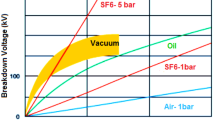Abstract
The analysis of the failure mechanics, namely hydrogen permeation of vacuum insulated tubing (VIT), indicated that the failure of VIT could be decreased but could not be avoided. To solve this problem, some measures by using non-vacuum materials were proposed and analyzed in this paper. The results show that to fill the tubing with foam-glass beads or high pressure argon may lead to a good performance.
Similar content being viewed by others
References
Yue H, Pang W, Duan Y, Zhang T, He Z, Deng D, Hou Q, Du J, Zhao X, Feng X. Integral completion technique for heavy oil thermal recovery. In: 2013 SPE Heavy Oil Conference Canada. Calgary, Canada, 2013, 1694–1704
Singh B, Miadonye A, Huang S S, Srivastava R, Puttagunta V R. Estimating temperature and pressure effects on viscosity of Saskatchewan heavy oils. Fuel Science and Technology International, 1994, 12(5): 693–704
Rothenberger K S, Howard B H, Killmeyer R P, Cugini A V, Enick R M, Bustamante F, Ciocco M V, Morreale B D, Buxbaum R E. Evaluation of tantalum-based materials for hydrogen separation at elevated temperatures and pressures. Journal of Membrane Science, 2003, 218(1–2): 19–37
Morreale B D, Ciocco M V, Enick R M, Morsi B I, Howard B H, Cugini A V, Rothenberger K S. The permeability of hydrogen in bulk palladium at elevated temperatures and pressures. Journal of Membrane Science, 2003, 212(1–2): 87–97
Ward T L, Dao T. Model of hydrogen permeation behavior in palladium membranes. Journal of Membrane Science, 1999, 153(2): 211–231
Lide D R. CRC Handbook of Chemistry and Physics. 90th ed. USA: The Chemical Rubber Co.(CRC) Press, 2010
Cormier K. Effective design of insulated tubing for a sour environment. SPE Production Engineering, 1990, 5(3): 221–224
Bai Z, Zhao X, Luo X, Luo S, Du L. Research on preparation and properties of hollow glass bead filled epoxy composites. Thermosetting Resin, 2009, 24(2): 32–35 (in Chinese)
Tsederberg N V. Thermal Conductivity of Gases and Liquids. Cambridge, USA: The M.I.T. Press, 1965
Bich E, Millat J, Vogel E. The viscosity and thermal conductivity of pure monatomic gases from their normal boiling point up to 5000 K in the limit of zero density and at 0.101325 MPa. Journal of Physical and Chemical Reference Data, 1990, 19(6): 1289–1305
Brokaw R S. Approximate formulas for the viscosity and thermal conductivity of gas mixtures. The Journal of Chemical Physics, 1958, 29(2): 391–397
Author information
Authors and Affiliations
Corresponding author
Rights and permissions
About this article
Cite this article
Zhou, C., Zhu, G., Xu, Y. et al. Novel methods by using non-vacuum insulated tubing to extend the lifetime of the tubing. Front. Energy 9, 142–147 (2015). https://doi.org/10.1007/s11708-015-0357-7
Received:
Accepted:
Published:
Issue Date:
DOI: https://doi.org/10.1007/s11708-015-0357-7




